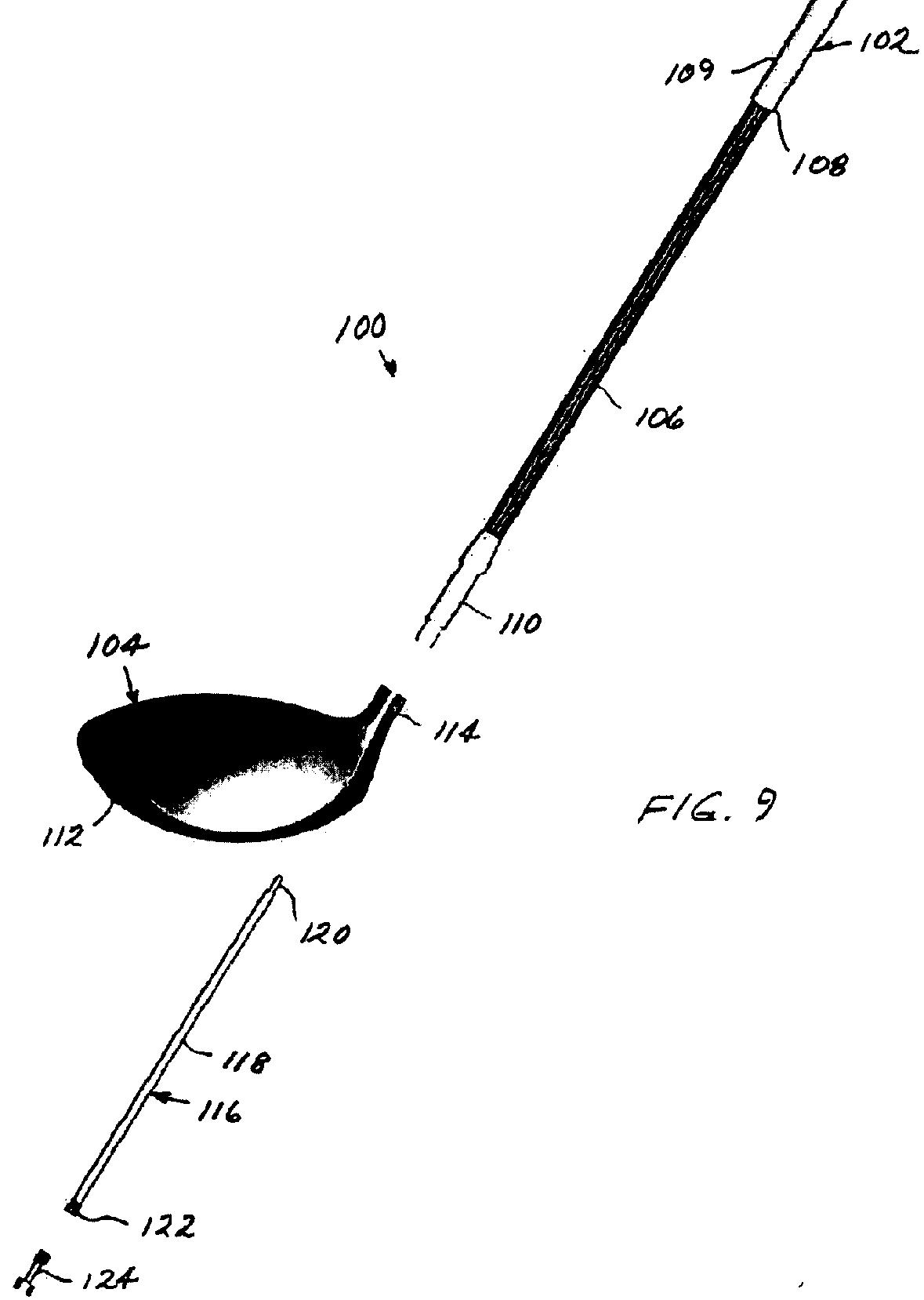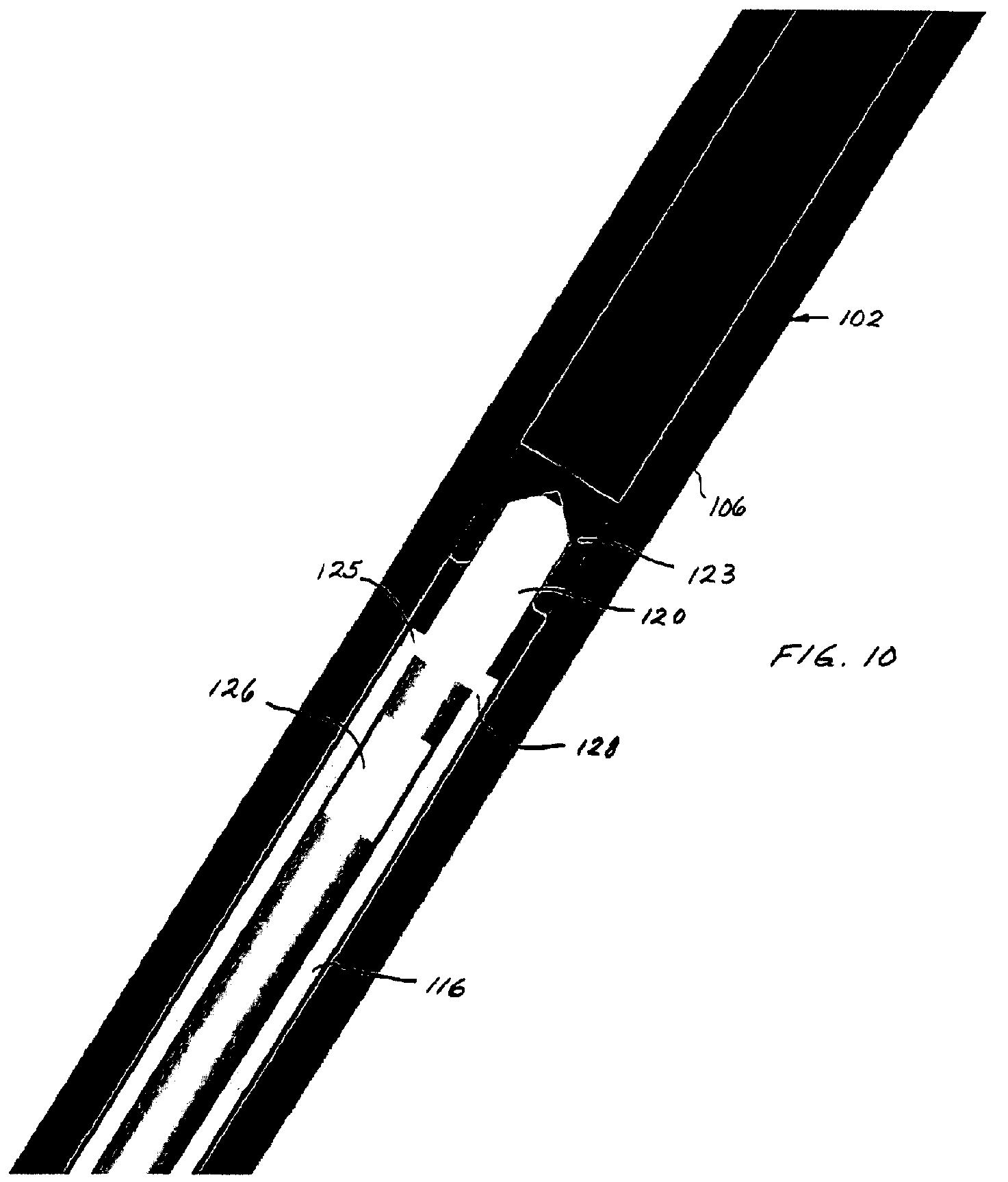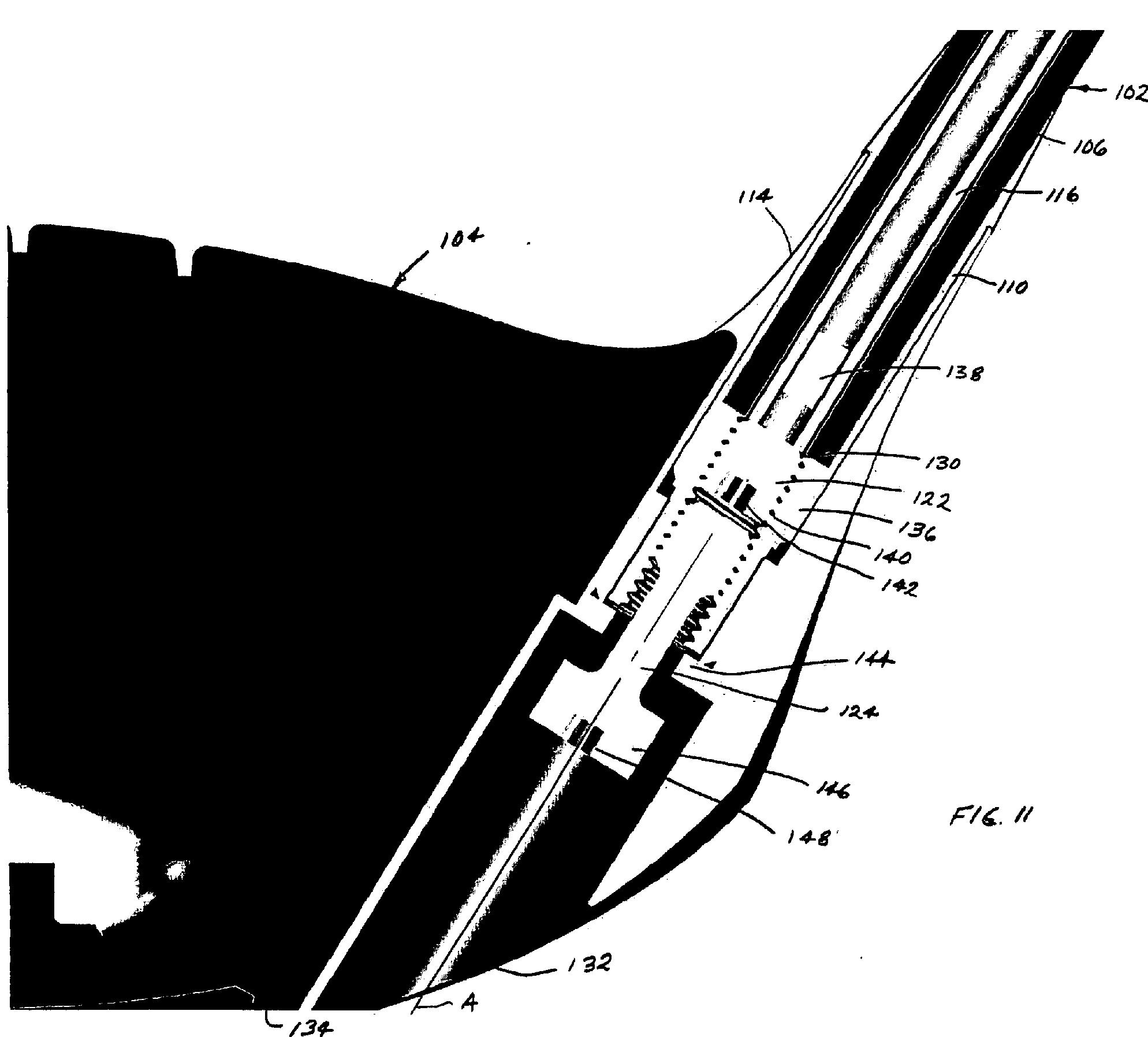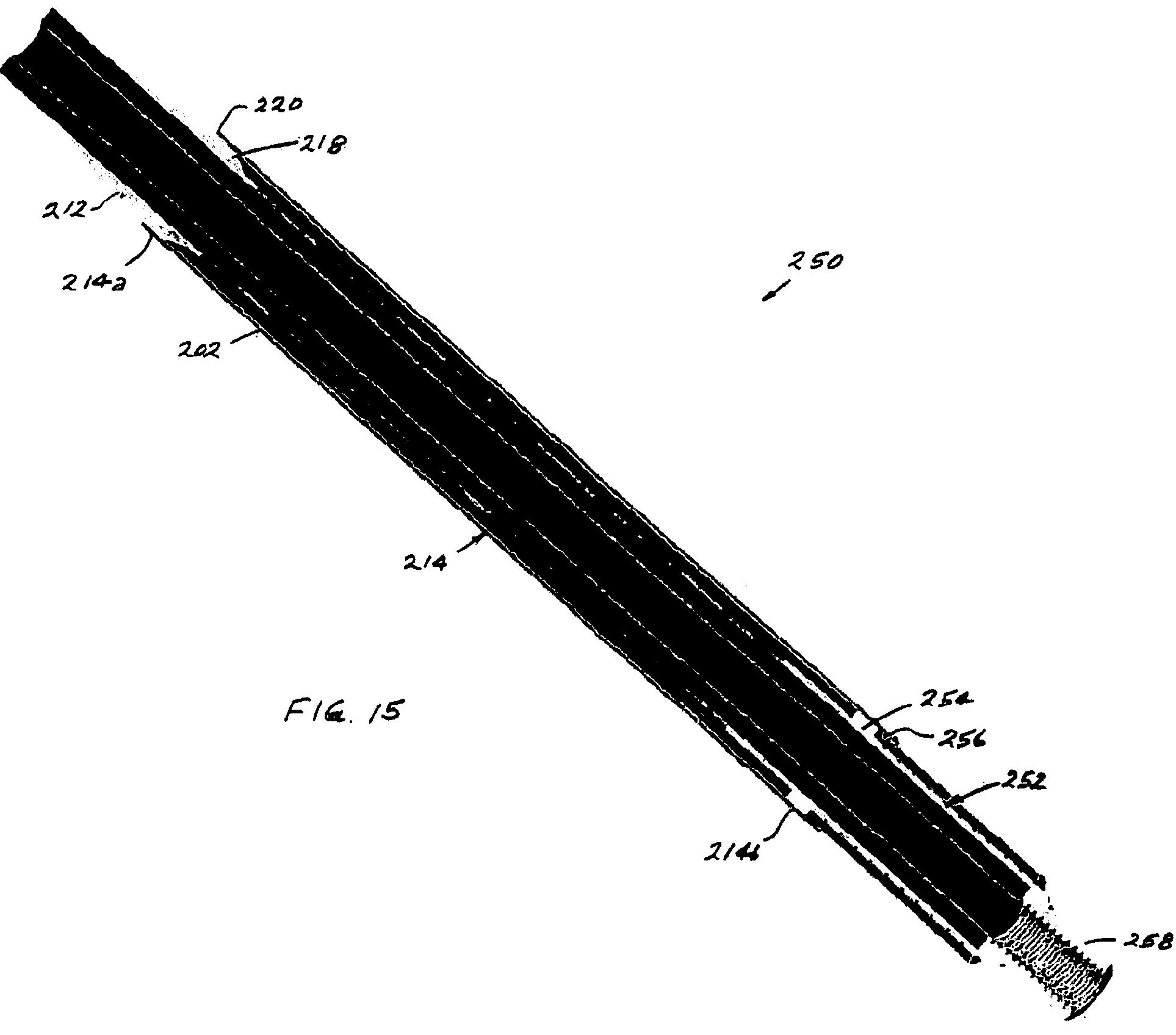What is the Next Step in Adjustability? Taylor Made is Considering Adjustable-Stiffness Shaft Tips
An interesting Taylor Made patent application published this week that may give us a look at their next step in adjustability; which means a new acronym! The application published as US Pub. No. 20090239677 titled “Golf Club Shafts Having Selectable-Stiffness Tip Regions, and Golf Clubs Comprising Same” and describes the application as:
The application goes on to explain:
Check out the design:




Is this an adjustability feature that you would pay a premium for?
Dave Dawsey - Keeping an Eye on Adjustable Golf Club Inventions
PS – check out more interesting posts on golf club adjustability here, here, here, here, here, here, and here
The subject golf clubs have a shaft and clubhead. The shaft has a tip-end coupled to the clubhead, a butt-end, a reduced-EI portion located adjacent the tip-end, and a remaining portion extending between the butt-end and the reduced-EI portion. The portions are coupled together at an interface. The remaining portion exhibits a respective rate of stiffness reduction as a function of distance from the butt-end. The reduced-EI portion is typically shorter than and has less stiffness than the remaining portion. A stiffener is coupled to the shaft, such as in the reduced-EI portion, to add stiffness locally. The reduced-EI portion exhibits a respective rate (which can be zero) of stiffness reduction as a function of distance toward the tip-end. These rates can be similar or different. The interface can exhibit a greater rate in stiffness reduction than the other portions. The stiffeners can be user-selectable, from a kit supplied with the club, for example. The clubhead can be removable from the shaft to facilitate stiffener exchange.
The application goes on to explain:
[0007] One factor having a relationship to shaft flexibility, particularly of the shafts of metal-wood type clubs, is "dynamic loft." Each of the different golf clubs in a set of clubs has a specified "loft," which is the angle of the strike plate from a vertical plane when the clubhead is stationary at the address position relative to the ball. Thus, the club's stated loft provides the golfer with approximate information on the expected launch angle of a ball hit by the club. However, a club's loft number is simply a physical angle; other factors (in addition to the club's specified loft) contribute to the loft actually exhibited by the club during use, i.e., the dynamic loft or actual launch angle of the club. Dynamic loft affects, in turn, the flight of the ball, including flight distance.
[0008] Another factor related to shaft flexibility is "droop," which is the deflection of the shaft, in the toe-down direction, perpendicular to the swing plane at the moment of impact with the ball.
[0009] A key determinant of dynamic loft, droop, and certain other behaviors exhibited by a clubhead during play is the flexibility of the shaft. As the golfer executes a swing, the clubhead accelerates from zero to high velocity (e.g., up to 80-100 mph) in a fraction of a second while sweeping radially in a substantially full-circular path as a result of force applied by the golfer to the grip. Hence, the shaft naturally flexes during the swing. The flexure results in changes in the orientation of the clubhead relative to the shaft (and to the ball) at the moment of impact, compared to a clubhead that is stationary adjacent the ball. The multi-variate effects of shaft flexibility can be complex and difficult to predict and model.
[0010] Some past development effort, aimed at improving club performance, has been directed to the shafts of golf clubs. For example, various attempts have been made to alter the EI profile in one or more selected regions of the shaft, i.e., to depart significantly from the normally substantially uniform rate of increase in flexibility down the length of the shaft. In this regard, U.S. Pat. No. 4,319,750 discusses composite shafts having increased flexibility in the butt-end region of the shaft, in the region of the grip. U.S. Pat. No. 5,439,219 discusses shafts having increased flexibility in a zone situated just downstream of the butt-end region, namely just below the grip. U.S. Pat. No. 7,070,512 discusses, with respect to certain wood-type clubs, shafts having increased flexibility (decreased stiffness) in a zone located upstream of the tip-end. The subject clubs have stated lofts ranging from 14 to 18 degrees. The low-stiffness zones have EI values of 5-10 N*m*m, and the shafts preferably include a small region of increased stiffness between the increased-flexibility zone and the clubhead. In other words, the rigidity of the shafts increases from the low-stiffness zone both toward the clubhead and toward the butt-end.
[0011] In view of the large influence of subjective criteria, categorically termed "feel," in the use of golf equipment, the various shaft-flexibility alterations noted in these references may be acceptable to certain golfers for certain golfing situations. But, for other golfers and/or other golfing situations, the alterations are not acceptable or effective.
[0012] Other factors affecting dynamic loft include prevailing weather conditions (wind, moisture, temperature), peculiarities of the golfer's swing, the spin imparted to the ball as struck by the club, and the particular golf course being played upon. (Spin is also affected, in turn, by the dynamic loft.) Since these factors are subject to change, it would be advantageous if the shaft flexibility of a particular club could be configured in a way that would yield a significant change in launch angle and ball spin. Pending a change in the relevant U.S.G.A. rules, it would also be advantageous if the flexibility of a region of the shaft of a particular club could be altered by the player in a way providing a degree of control over the effects of these factors. Certain advantages also could be realized if a club were provided having a shaft of which the local flexibility could be selectively manipulated for different golfer and/or to address situations arising during play.
[0013] The foregoing and other needs are addressed by golf clubs as disclosed herein, of which various embodiments have a shaft comprising a first length region, a second length region, and a third length region. The first length region is the grip region (or "butt region"), the third length region is the tip region, and the second length region extends between the first and third length regions. The second length region has less stiffness than the first length region. The respective junctions between the first and second length regions and between the second and third length regions need not be abrupt. An "interface" is situated in the lower part of the second length region, in the upper part of the third length region, or in both parts. The lower part of the third length region is the tip-end to which a clubhead is mounted. A grip is normally mounted to the first length region.
[0014] In various embodiments at least one stiffener is engaged with, and coextensive with, the third length region up to at least the interface. The stiffener contributes stiffness to the shaft, particularly where the stiffener is located on the shaft.
[0015] The first and second length regions (or at least the second length region) desirably exhibit a respective progressive reduction in stiffness from the butt-end to the interface. A respective progressive reduction in stiffness is also exhibited from the interface to the tip-end. The respective rates of stiffness reduction, as a function of axial distance, in the shaft regions from the butt-end to the interface and from the interface to the tip-end, can be similar or different. The interface is a locus at which these respective rates of stiffness-reduction change from the respective rates from the first length region to the interface and from the interface to the tip-end. The locus can be either in the lower part of the second length region, in the upper part of the third length region, or in both parts. The respective shaft regions from the butt-end to the interface and from the interface to the tip-end can be made of similar or dissimilar materials. Also, the configurations (e.g., hollow versus solid) of the length regions can be similar or different.
[0016] The stiffener can be "internal" (situated inside the lumen of the shaft if the shaft is hollow) or "external" (situated outside the shaft in the manner of a sleeve or the like), or a combination thereof. Desirably, the stiffener is coaxial with the shaft. The stiffener desirably is detachable, allowing the golf club to be used without the stiffener, or with multiple different stiffeners. Since the region of the shaft from the interface to the tip-end exhibits reduced stiffness compared to other regions of the shaft, the golf club without the stiffener provides a shaft of which the shaft region from the interface to the tip-end exhibits minimal stiffness. By attaching a stiffener in at least this shaft region, the user effectively "adds back" stiffness to the shaft. The amount of stiffness added in this manner can vary, depending upon the stiffness of the stiffener and the manner in which the stiffener is attached to the shaft. In some instances, the stiffener can add sufficient stiffness to provide the shaft with an overall stiffness profile similar to a conventional golf club, in which the shaft has a substantially linearly progressive reduction of stiffness from the butt-end to the tip-end. In other instances, the stiffener adds a smaller or larger increment of stiffness.
[0017] In many embodiments (although not all embodiments), the clubhead is detachable from the tip-end of the shaft to facilitate attachment and detachment of stiffeners. In certain embodiments, attachment and detachment of the clubhead are performed using the same tool as used for attachment and detachment of the stiffener. In other embodiments, detaching the clubhead renders the stiffener removable without having to use a tool. This latter configuration can comprise a fastener (e.g., securing screw) that secures the clubhead to the shaft while simultaneously securing the stiffener to the shaft. In yet other embodiments the stiffener is attachable and detachable without having to remove the clubhead from the shaft.
[0018] In view of the above, it will be understood that a given golf club can include a "kit" of multiple stiffeners each providing a respective selective amount of "add-on" stiffness to the second length region. During practice or before commencing a round of golf, the golfer encountering a particular play situation selects a particular stiffener and attaches it to the shaft. If desired, multiple stiffeners can be used simultaneously, such as an internal stiffener and an external stiffener. Alternatively or in addition, a stiffener providing a particular stiffness can be selected and installed in a club at the point of sale, thereby providing a customized club for the purchasing customer. In this situation, the retailer can be provided with a kit of stiffeners and selects and installs a stiffener in a club according to the needs of the customer.
[0019] According to another aspect, golf clubs are provided that comprise a shaft including a butt-end, a tip-end, a length extending from the butt-end to the tip-end, and an interface at a location along the length. The length includes a major-length portion extending from the butt-end to the interface and a minor-length portion extending from the interface to the tip-end. The minor-length portion is shorter and has less stiffness than the major-length portion. A clubhead is mounted to the tip-end, and the butt-end includes a grip. The major-length portion exhibits, in a plot of stiffness (EI) versus distance from the butt-end to the interface, a substantially linearly progressive reduction in stiffness. This plot has a first slope. The minor-length portion exhibits, in a plot of stiffness (El) versus distance from the interface to the tip-end, a substantially linearly progressive reduction in stiffness. This plot has a second slope, which can be substantially equal to the first slope. The interface comprises a juncture of the major-length and minor-length portions and exhibits a downward shift in stiffness, from the major-length portion to the minor-length portion, that is at a greater slope than the first slope. The lowest stiffness in the minor-length portion is 10 N*m*m or higher at the tip-end.
Check out the design:




Is this an adjustability feature that you would pay a premium for?
Dave Dawsey - Keeping an Eye on Adjustable Golf Club Inventions
PS – check out more interesting posts on golf club adjustability here, here, here, here, here, here, and here

Comments